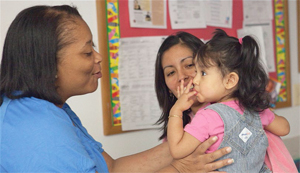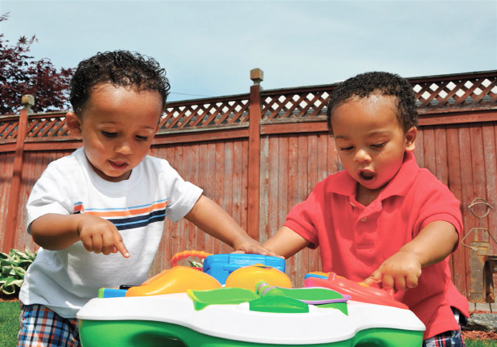Sub-Domain: Emotional and Behavioral Self-Regulation
Goal IT-ATL 1. Child manages feelings and emotions with support of familiar adults.
| Developmental Progression | Indicators | |||
|---|---|---|---|---|
| Birth to 9 Months | 8 to 18 Months | 16 to 36 Months | By 36 Months | |
| Engages with familiar adults for calming and comfort, to focus attention, and to share joy. | Seeks to be close, makes contact, or looks to familiar adults for help with strong emotions. | Uses various strategies to help manage strong emotions, such as removing oneself from the situation, covering eyes or ears, or seeking support from a familiar adult. |
| |
Goal IT-ATL 2. Child manages actions and behavior with support of familiar adults.
| Developmental Progression | Indicators | |||
|---|---|---|---|---|
| Birth to 9 Months | 8 to 18 Months | 16 to 36 Months | By 36 Months | |
| Responds to attentive caregiving by quieting or calming down, such as when being fed or being comforted during moments of physical distress. | Looks to familiar adults for assistance and guidance with actions and behavior. May try to calm self by sucking on fingers or thumb when overly excited or distressed. | Begins to manage and adjust actions and behavior with the guidance of familiar adults using words or signs such as "Stop" or "No" during conflict with a peer instead of hitting. Lets the adult know when they are hungry or tired. |
| |
 The strategies children use to manage strong emotions may vary based on cultural background. For example, some children may be much more likely to use self-soothing strategies while others may seek out comfort from adults.
The strategies children use to manage strong emotions may vary based on cultural background. For example, some children may be much more likely to use self-soothing strategies while others may seek out comfort from adults.Sub-Domain: Cognitive Self-Regulation (Executive Functioning)
Goal IT-ATL 3. Child maintains focus and sustains attention with support.
| Developmental Progression | Indicators | |||
|---|---|---|---|---|
| Birth to 9 Months | 8 to 18 Months | 16 to 36 Months | By 36 Months | |
| Develops some ability to filter out distracting sensory stimuli in order to focus on and attend to important people or objects in the environment with support. | Shows increasing ability to attend to people, objects, and activities in order to extend or complete an activity, or to join others in a common focus. | Participates in activities and experiences with people, objects, or materials that require attention and common focus. |
| |
Goal IT-ATL 4. Child develops the ability to show persistence in actions and behavior.
| Developmental Progression | Indicators | |||
|---|---|---|---|---|
| Birth to 9 Months | 8 to 18 Months | 16 to 36 Months | By 36 Months | |
| Shows increasing ability to continue interactions with familiar adults or toys for more than just a brief time. | Shows willingness to repeat attempts to communicate or to repeat actions to solve a problem even when encountering difficulties. | Shows increasing ability to stay engaged when working towards a goal or solving a problem. Often tries different strategies until successful. |
| |
Goal IT-ATL 5. Child demonstrates the ability to be flexible in actions and behavior.
| Developmental Progression | Indicators | |||
|---|---|---|---|---|
| Birth to 9 Months | 8 to 18 Months | 16 to 36 Months | By 36 Months | |
| Shows repetitive patterns in actions or behaviors but sometimes tries more than one approach to solving a problem or engaging someone in interaction. | Shows ability to shift focus in order to attend to something else, participate in a new activity or try a new approach to solving a problem. | Modifies actions or behavior in social situations, daily routines, and problem solving, such as playing quietly when asked or adjusting to changes in schedule. |
| |
Sub-Domain: Initiative and Curiosity
Goal IT-ATL 6. Child demonstrates emerging initiative in interactions, experiences, and explorations.
| Developmental Progression | Indicators | |||
|---|---|---|---|---|
| Birth to 9 Months | 8 to 18 Months | 16 to 36 Months | By 36 Months | |
| Initiates interactions with familiar adults through expressions, actions, or behaviors. | Points to desired people, objects, or places, and initiates actions, such as looking for a favorite toy or bringing a book to an adult to read. Actively resists actions or items not wanted. | Prepares for or starts some activities without being directed by others, such as getting ready for the next activity or bringing a ball to a new child at the playground. |
| |
Goal IT-ATL 7. Child shows interest in and curiosity about objects, materials, or events.
| Developmental Progression | Indicators | |||
|---|---|---|---|---|
| Birth to 9 Months | 8 to 18 Months | 16 to 36 Months | By 36 Months | |
| Shows excitement when engaged in learning, such as smiling at an adult, laughing after batting at a mobile, or knocking over a toy. | Approaches new events, experiences with others, or materials with interest and curiosity, such as intently listening to a new song or examining new toys or materials. | Participates in new experiences, asks questions, and experiments with new things or materials, such as collecting leaves and pinecones in the fall. |
| |
Sub-Domain: Creativity
Goal IT-ATL 8. Child uses creativity to increase understanding and learning.
| Developmental Progression | Indicators | |||
|---|---|---|---|---|
| Birth to 9 Months | 8 to 18 Months | 16 to 36 Months | By 36 Months | |
| Uses a variety of ways to interact with other people. Modifies expressions, actions, or behaviors based on responses of others. | Finds new things to do with familiar, everyday objects, such as using a cooking pot for a hat or a spoon as a drumstick. | Combines objects or materials in new and unexpected ways. Shows delight in creating something new. |
| |
Goal IT-ATL 9. Child shows imagination in play and interactions with others.
| Developmental Progression | Indicators | |||
|---|---|---|---|---|
| Birth to 9 Months | 8 to 18 Months | 16 to 36 Months | By 36 Months | |
| Emerging | Uses sounds, gestures, signs, or words playfully through songs, finger plays, or games. | Uses imagination to explore possible uses of objects and materials. Engages in pretend or make-believe play with other children. |
| |
 Toddlers enjoy using their imagination in play and in interactions with other children. They show delight in doing something new.
Toddlers enjoy using their imagination in play and in interactions with other children. They show delight in doing something new.Last Updated: May 21, 2024
